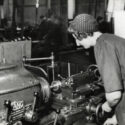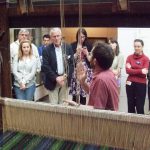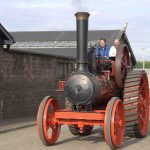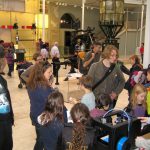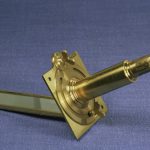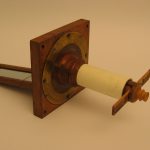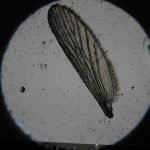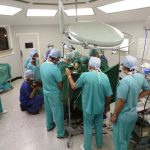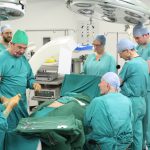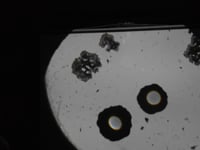A symposium on histories of use and tacit skills
Keywords
histories of use, re-enactment, reconstruction, restoration of behaviour, reworking, tacit skills
Tim Boon: Introduction
https://dx.doi.org/10.15180/170808/001The Science Museum Research Centre Inaugural Conference in April 2016 provided the opportunity not only to celebrate mature programmes of research, but also to highlight areas that seem to us to be growth points for future activity. The histories of tacit skills and knowledge that were entailed in the use of objects from our collections during their ‘working lives’ is one such topic. The conference provided a first opportunity to ‘go public’ with some conversations between the participants that have been underway for the last few years. In these enthusiastic encounters, the potential of re-enactment, reconstruction, replication, restoration of behaviour and object-guided oral history to enrich understanding of practice and objects has become clear.
We are optimistic that it will soon be possible to commence funded research projects in this area, but we are also sufficiently convinced of the virtue of combining insights from the differing traditions of practical investigative technique represented here to feel that it is worth publishing the authors’ contributions at this stage. Klaus Staubermann, a curator, starts our selection with insights from practice at National Museums Scotland, as he argues for going beyond the study of two-dimensional evidence – including photographs – to the replication of artefact experiences. Peter Heering illustrates the kinds of insights that can be gained from operating late eighteenth-century and early nineteenth-century physics apparatus, in this case, solar microscopes. Roger Kneebone, in a summary of his work in simulation-based surgical replication, demonstrates how practical research techniques can yield a panoply of unexpected insights. Yves Winkin concludes our selection with a helpful battery of theoretical resources for thinking about the performances and gestures that constitute the basic ‘language’ of the operation of machines, instruments and equipment.
These sections may well seem disparate, but that is the point. Our shared intuition is that, although practical investigative techniques have been in widespread use, they have ploughed rather separate furrows, and so there is much to learn from bringing these techniques into dialogue with each other, for the sake of gaining deeper understanding of past practices and, in the museum context, of illuminating the histories of the objects we curate. Certainly, on the day of the conference, there was considerable shared excitement about the potential for shared investigations.
We are here concerned with two intimately related concepts: histories of use of objects (which is becoming a significant interest for museum curators) and tacit skills (those unspoken, unrecorded, aspects of practice that have been the concern of philosophers, sociologists and others beyond the museum world). We propose that these two aspects are, in fact, two sides of the same coin: histories of use will benefit from being understood in the light of a wide range of intellectual traditions, whilst the study of tacit skills will benefit from its re-association with the material world of objects.
There is another binary distinction that lies at the heart of our shared areas of interest, and the division lies at the horizon of human memory, as Roger Kneebone concurs in his section. Several of the techniques of practical investigation of the past rely on recall, whether that is verbal or ‘muscle memory’. But for earlier periods as represented by Peter Heering’s contribution, or Kneebone’s time-travelling operating theatre, past practice must be painstakingly recreated by close study of a wide range of sources. Here, the museum object itself – as we can see with the example of the solar microscope – may be the most eloquent of witnesses. But the insight gained is radically different from that provided by the object-guided oral history of, for example, an anaesthetist reunited with a ‘Boyle Machine’ anaesthetic ventilator as used earlier in his career. In the first case, there is witness to an experience enjoyed by our antecedents; in the other, there is the potential of disinterring buried recollection. But distinctions invite comparison and dialogue, and that is the aim of the work we have in prospect.
Klaus Staubermann: Museums, tools and the tacit
https://dx.doi.org/10.15180/170808/002I want to introduce tacit skills by looking at objects that are sometimes perceived to be boring, rather than ‘iconic’ objects usually found in museum displays, such as Dolly the Sheep or Concorde. It is easy to overlook the ninety per cent or more of our collections that are not on display but kept in storage, and to make the assumption that absence from display equates with lack of intrinsic interest. But it is the curators’ or historians’ responsibility to interpret and make sense of all objects, whether ‘exciting’ or ‘boring’. This responsibility comes with the added challenge: to keep these collections ‘alive’, to capture their history and share it with our audiences. There are many different approaches to understanding objects, including looking into their makers and users. But how do we capture this knowledge and how do we bring it back to life? The easiest way is probably to draw on living experience, knowledge and memory. This means speaking to people that use or used objects and capturing and recording their experience with the object. There are other approaches to capturing historic knowledge of course, for example, through trade catalogues, order books, blueprints, design drawings or photographs.
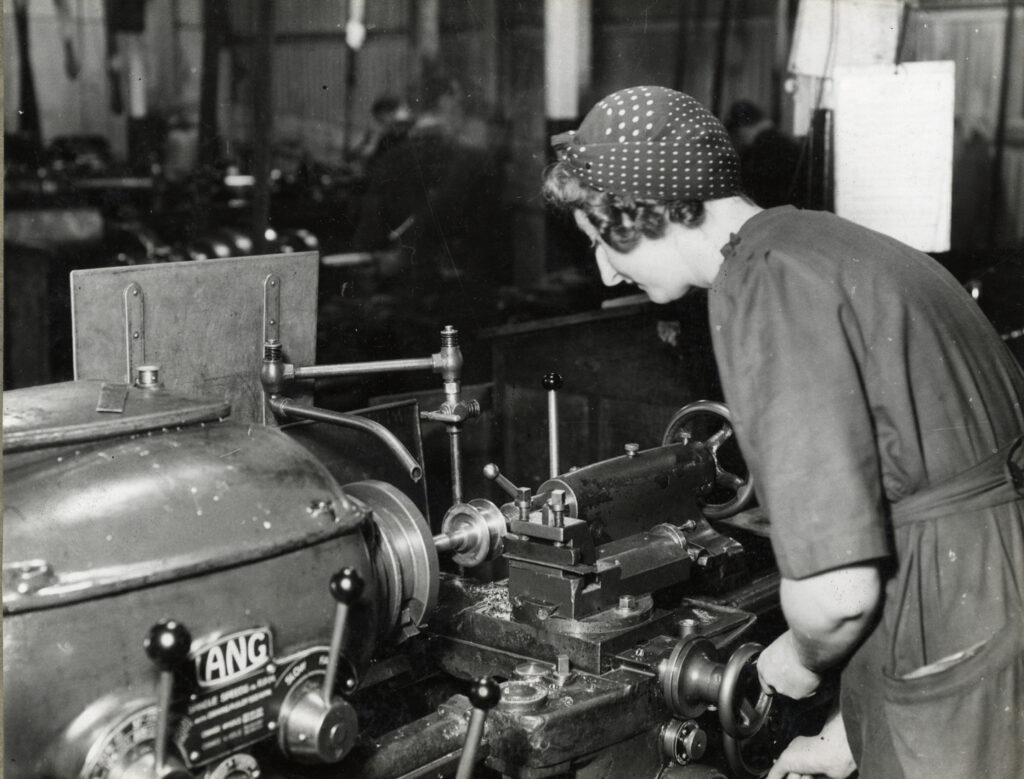
But it is important to note that not every skill is recorded. There are tacit skills or, more broadly, tacit knowledge that is not recorded, perhaps because it was not considered relevant at the time or it was simply not recordable. Think of a DVD player today: if the instructions tell us to connect it to 220-240 volt AC we know what that means, but two hundred years from now this knowledge might be lost. Images can be helpful sources: take, for example, the image of the machine tool above (see Figure 1) in which one might notice a water supply pipe. Little might be known and documented about its use, although one could speculate that it was used to clean or cool a work piece. We need to be careful with the interpretation of images, however. This image could, for instance, lead to the assumption that women were a normal part of the workforce. But the women depicted were part of the war effort and remained the exception in many industries. Photographs can help us to understand some tacit aspects of practice, such as the need to protect one’s hair or not to wear long sleeves that might get entangled in the machine. Beyond what is deducible from photographs, other tacit dimensions might include the role of noise, temperature or humidity and how these affect the workplace, worker or workpiece. The physical investigation of museum objects offers another source of evidence for historic practices. Traces of historic activity can be manifested in damage, wear or stains (although such evidence may often have been reduced or removed by museum practices such as object cleaning).
A dimension of context that is often overlooked in museums is the scale of production. Museums tend to collect individual objects, and this risks giving the impression that these were one-off items, whereas they were often part of large-scale production or even mass-production. Machine tools like the one pictured in Figure 1 were produced by the thousands and supplied to the Empire and beyond. Many were scrapped later and only a few ended up in museums. This again is something we need to bear in mind when we talk in the museum context about the making and uses of these objects. Furthermore, objects such as machine tools would have been accompanied by parts and spares, witnesses to customisation and use, many of which may not have found their way into museums and must be considered lost today.
The history of an object continues across its working life. For example, a machine tool that has been built in Scotland might get used in Eastern Europe and after that in the Near East and eventually in Asia. The history of use is also a history of customisation, maintenance and repair which is often reflected in the surviving artefact. It is very much a global history, a history of appropriation of materials and techniques. How do we capture this history and how do we, in the museum, keep these techniques alive? One possible approach is via performance. In the figures below you see a weaver operating one of the looms on our galleries at National Museums Scotland (see Figure 2) and one of our traction engines, a 1906 Marshall, driven by me and a former colleague (see Figure 3). We are operating these machines to keep the associated historic practices alive.
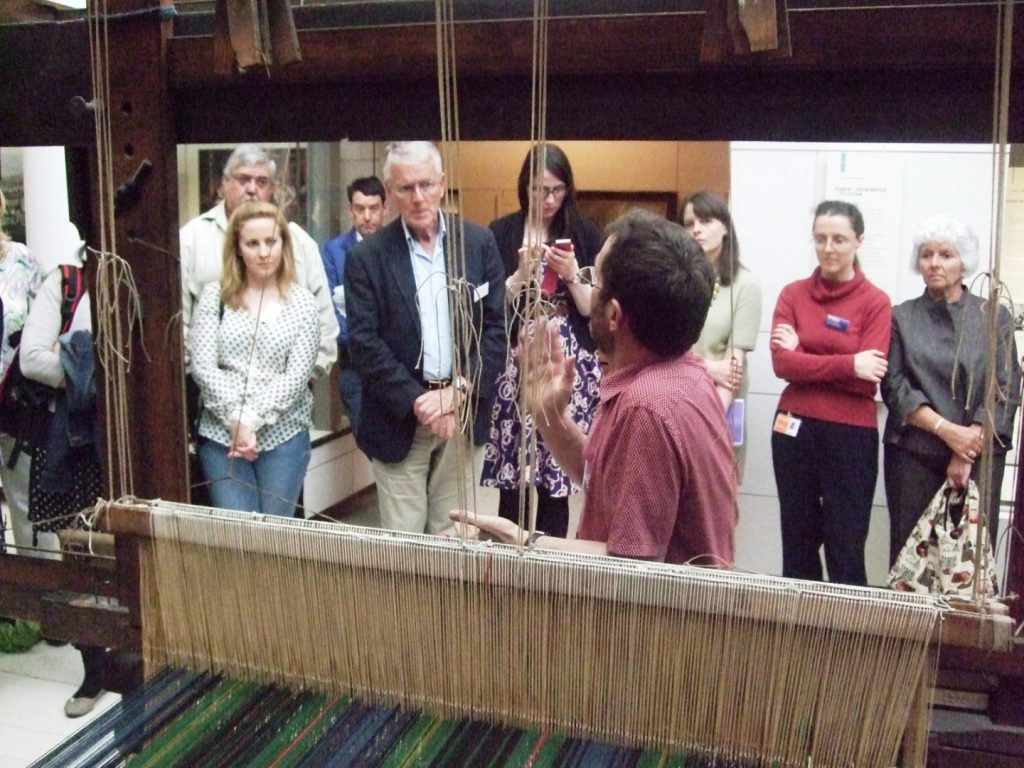
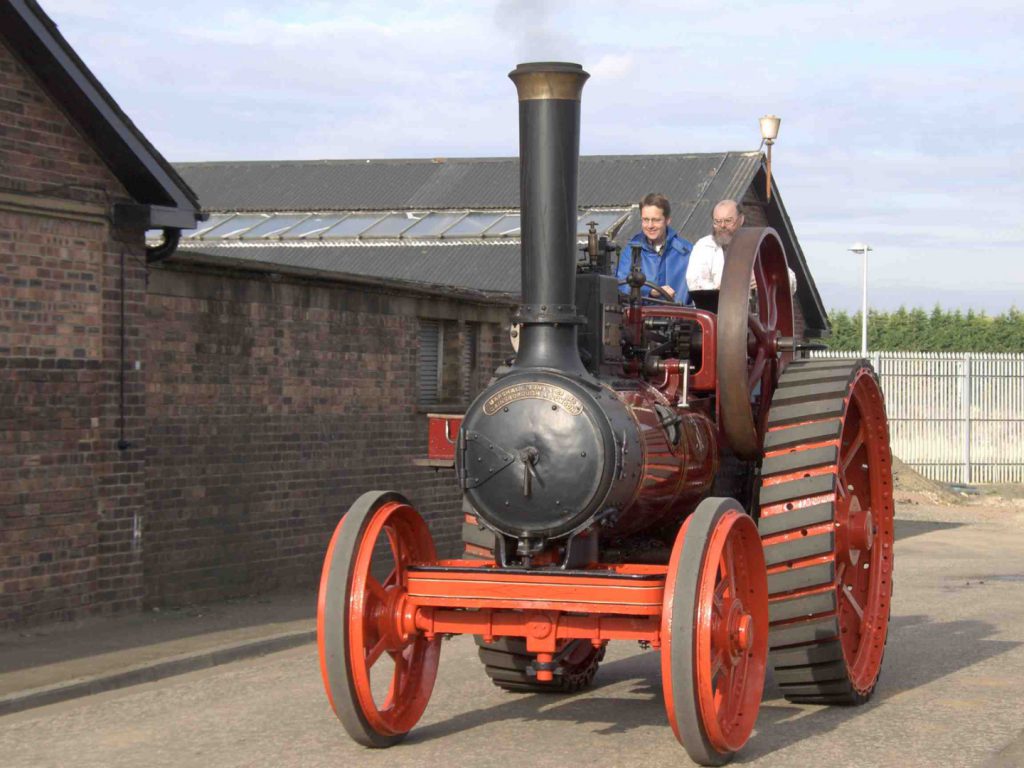
Where museum conservation permits, working with the actual object enables us to obtain a deeper understanding of its form and function. When we cannot use actual artefacts, for example for conservation reasons, it is sometimes possible to rebuild objects, and this in return enables us to explore their design, manufacture and uses.
Replicating artefact experiences, which means rebuilding and re-enactment, can provide us with a deeper and more complex understanding of historic practice and techniques. This can include haptic or gestural experiences but also the recreation of sound, vision or even taste. If, for example, the actual artefact is not in existence anymore we can reconstruct it, which process itself enables us to reconstruct a making experience which otherwise would have been lost. Replication has its origins in experimental archaeology and has become a powerful research and teaching method in the history of science and technology during the past thirty years (Staubermann, 2011).
The potential for research is clear, but how we can convey these historic practices and techniques to our museum audiences, especially in those cases where we cannot demonstrate or operate the actual artefacts on our galleries? Participation enables us to communicate complex knowledge and this is something both children and adults benefit from, but especially children because of their broad multisensory approach to the world. This can reach from exhibition interactives to workshop events.
My last figure (see Figure 4) shows 3D printing in our galleries, an example of a participatory activity we are currently experimenting with. Here visitors can print their own objects which then go on to display. This is an example of where active creation in the museum closes the circle between designer, maker, user and visitor. Here, the visitor can become her or his own exhibition maker and perhaps it is this public participation centred on manufacture that marks the museum of the future.
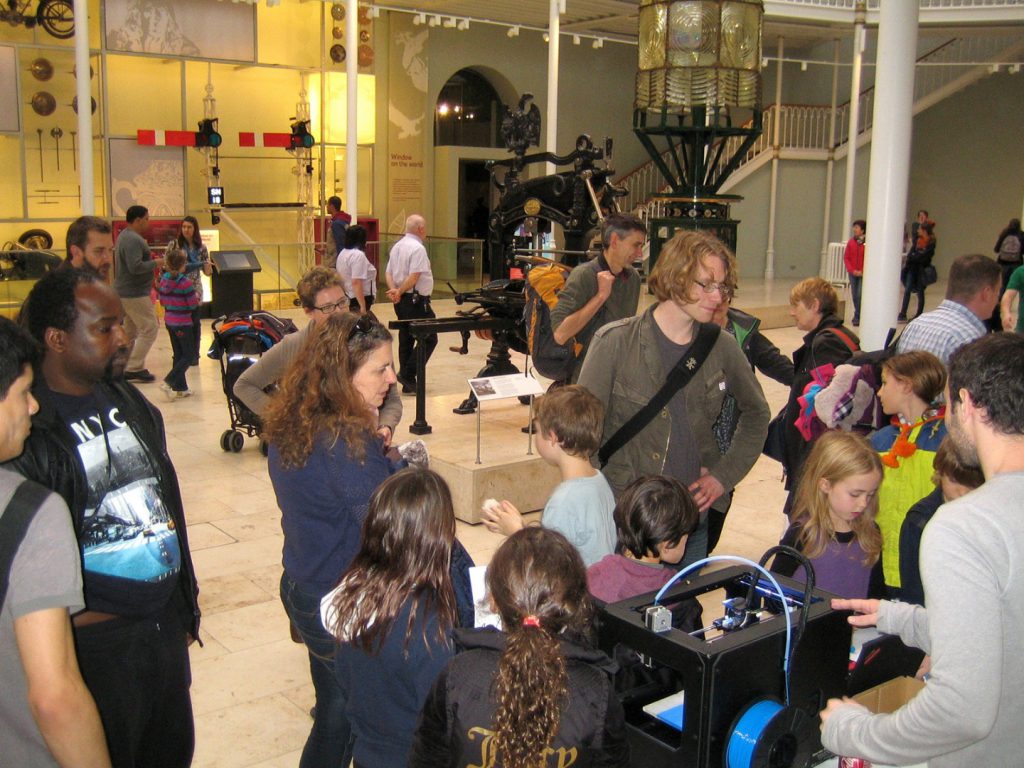
Peter Heering: Analysing experiments with the replication method
https://dx.doi.org/10.15180/170808/003Analysing experiments with the replication method is normally constituted by three closely interwoven steps – the reconstruction of the apparatus (or the set-up), the re-enactment of the experiment, and the contextualisation of the experiences made. In this respect, this case study on solar microscopes is somewhat unusual as most experiences were made with original instruments that belong to the collection of the Deutsches Museum Munich (Heering, 2008; Heering, 2009). Even though I afterwards did some work with a reconstructed solar microscope, the discussion will mainly focus on the experiences in Munich.
Solar microscopes are projection devices that were rather popular in the second half of the eighteenth device. and which are closely connected to the experimental culture of the Enlightenment. The instrument uses sunlight reflected with a mirror on to a condensing lens. This light illuminates the microscopic specimen that is placed close to the focal point of the lens. The image of the specimen is projected via a lens or a lens system on to a screen. The instrument is used in a darkened chamber; it is placed in the shutter of a window so that the mirror is outside the room. The popularity of the instruments cannot be inferred from printed sources only, even though solar microscopes are found in most eighteenth-century instrument makers’ catalogues as well as in textbooks. Also, the number of instruments that still exist and are kept in museum collections may serve as an indication of their popularity. To give a few examples: the Science Museum and Rijksmuseum Boerhaave each have more than 35 instruments; the Museum for the History of Science Oxford has 45. Moreover, when looking at contemporary accounts, eighteenth-century natural philosophers are very positive about the potential of the instrument. To give just one example: Joseph Priestley wrote that ‘…the image or picture of the object is thrown distinctly and beautifully upon a screen of white paper, and may be magnified beyond the imagination of those who have not seen it’ (Priestley, 1772, p 742). This statement presents an interesting problem to the historian of science – when the magnification is beyond the imagination of those who have not seen it, this makes it challenging to estimate the performance of the device. To make things worse, a different characterisation can be found in publications from the nineteenth century. ‘The image of a common solar microscope may be considered as a mere shadow, fit only to amuse women and children […] The utmost it can do is to give us the shadow of a flea, or a louse as big as a goose or a jackass…’ (Goring, 1827, in Altick 1978, p 369).
This was one of the starting points of my research with instruments at the Deutsches Museum. Among the instruments kept in the collection was one device signed ‘Dollond’ that dates from around 1780 (see Figure 5), and another by Junker that dates from around 1791 (see Figure 6). Both instruments had sliders with the accompanying specimens still in existence. Whilst Dollond’s instrument can be seen as state of the art, Junker’s instrument is technically less sophisticated – this is related to Junker’s intention: he wanted to build a solar microscope that would be substantially cheaper and could be used in schools (Heering, 2011).
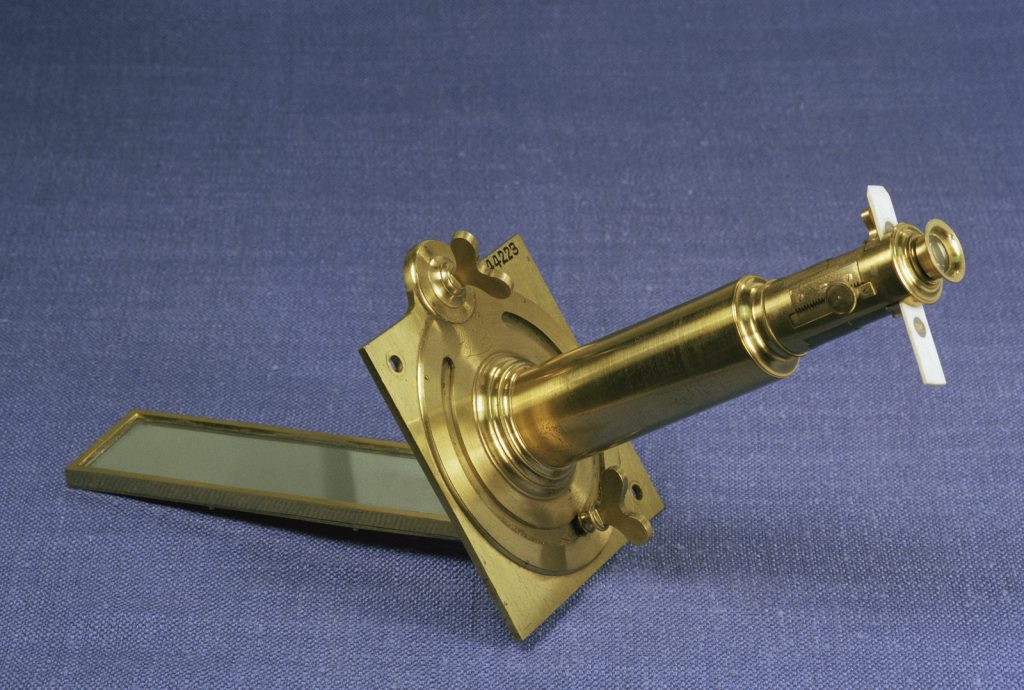
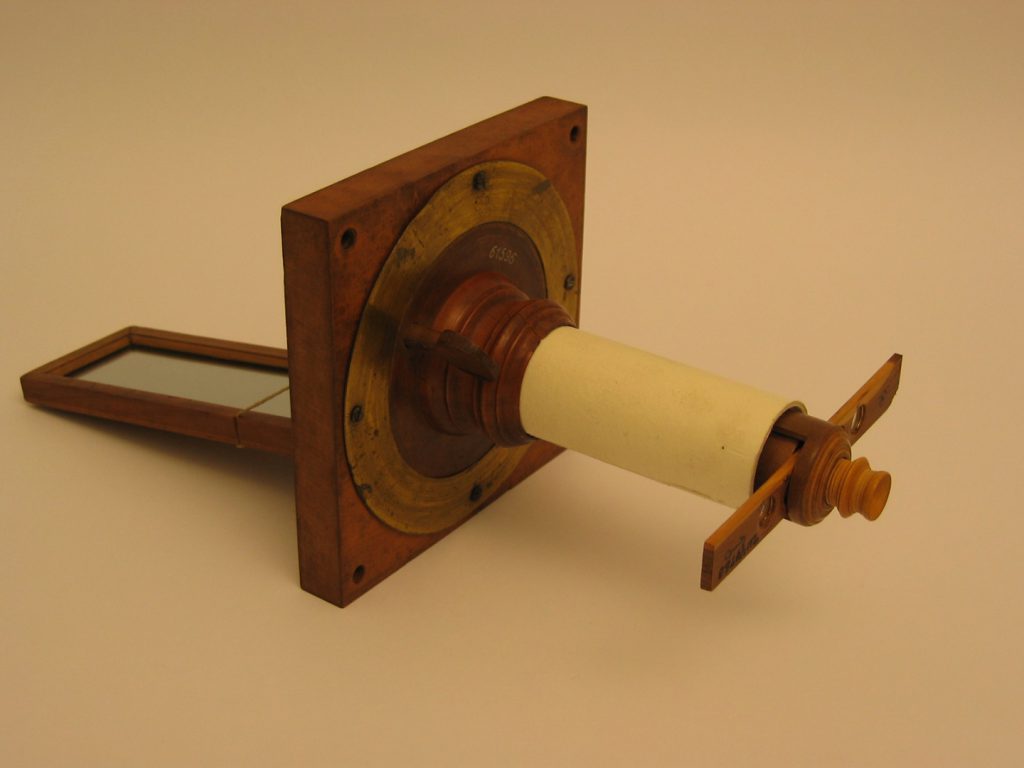
Replication was needed to compare the experience each instrument gave. Once I had made a room completely dark (which itself turned out to be a challenge), I started working with the instruments and immediately realised that indeed the images are very bright, and very large (see Figure 7). I also realised that the visual impression cannot be communicated in words – one has to see the images in order to understand the visual potential of these devices. This was not just my impression but also part of the feedback I received when I started doing demonstrations for audiences. This activity was evaluated with questionnaires; one was used prior to the demonstration to address expectations, the other immediately afterwards to assess the actual experiences. The impressiveness of the effect is also evident in Elizabeth Cavicchi’s 2008 account of the demonstration she attended: ‘Even Cuff’s evocative and promotional words are inadequate to describe what it was like when sunlit images from Dollond’s brass tube filled the fabric screen in our dark lab. Minute relics of the microscopic past were projected to human-sized height while retaining crisply edged detail and brilliance as if possessed of dimensions comparable to our own. What we saw, lit up with lacework shadows, was astonishing. The effect was as startling as if seeing something so enlarged were novel…’ (Cavicchi, 2008, p 374). It appears to be remarkable that people in the twenty-first century are still affected by these images, but this is not the line of argument I am going to follow here.
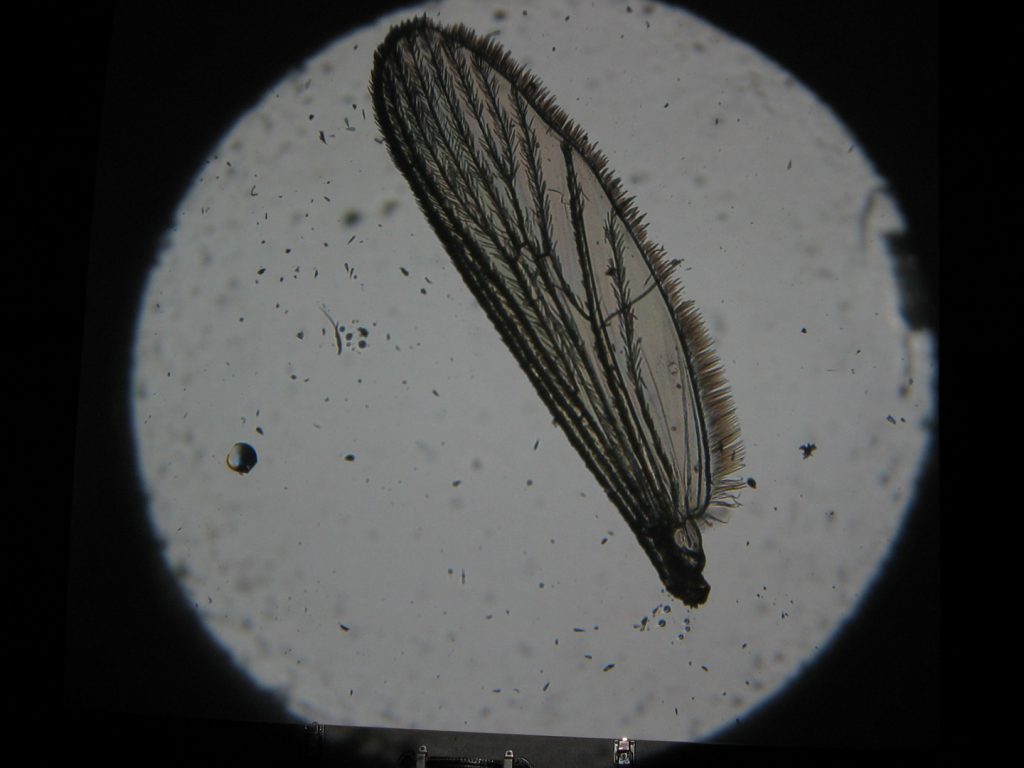
Instead, I will discuss some of the results of the contextualisation that developed out of the experiences made with the solar microscope. When looking into the eighteenth-century literature about microscopy, a number of accounts were striking to me, accounts such as the following one by the Augsburg instrument maker Brander: ‘What can be more pleasant and more appealing but when we – even without stepping out of our parlour – seemingly catch sight of a new world, or at least of completely new inhabitants, that were up to now entirely unknown to us? Our attention will be most excited when we encounter at an innumerable amount of midget animalcules in the smallest drop of water the same order, that we observe in the macroscopic and even in the entire cosmos’ (Brander, 1769, Vorbericht, n.p.).
Such a description does not correspond with what I experienced with the solar microscope. According to Brander’s description, the instrument stands between the observer and the microcosm – it may be seen as a mediator between the two worlds but at the same time separates the observer from the inhabitants of the microcosm. Yet this is completely different with the solar microscope: here, we have an instrument that creates a particular space in which humans can meet the inhabitants of the microcosm (see Figure 8). This space is no longer part of the outside world, which gets evident as soon as it gets dark. This happens when a cloud moves between the Sun and the mirror, thus blocking the sunlight. One immediately realises that something has happened outside, but cannot tell whether it is worth standing in darkness and waiting for the light to reappear (when the cloud does not block it anymore), or whether the projection time is over.
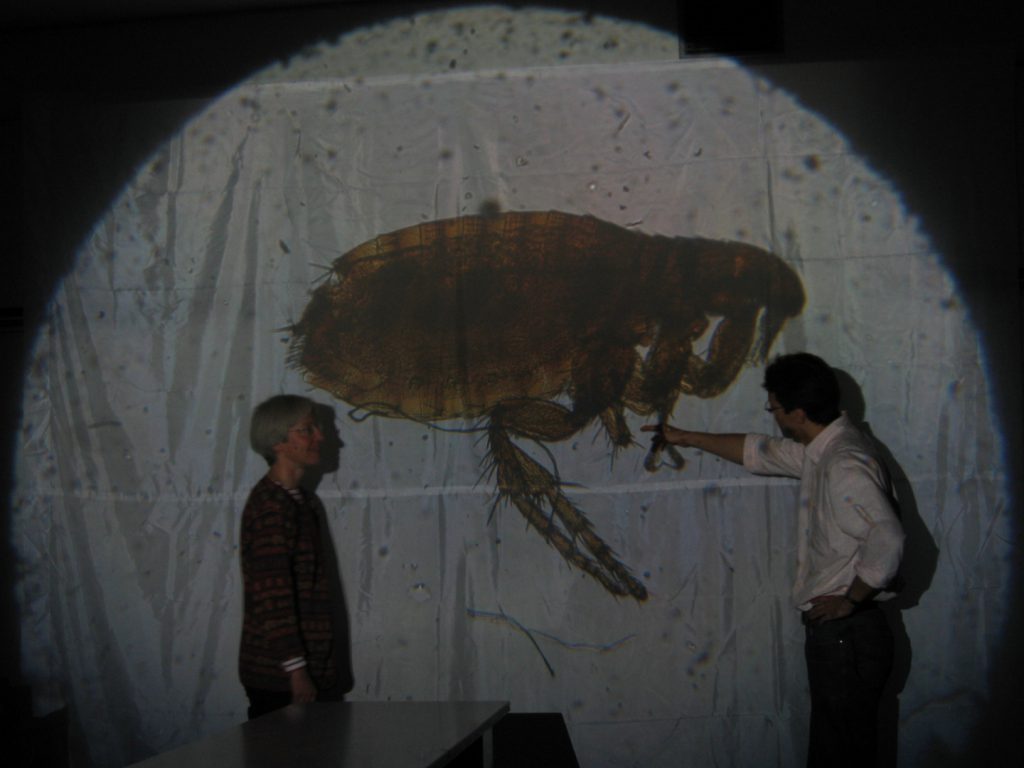
Yet more important appears to be that the created space enables an encounter with the inhabitants of the microcosm – this perception can also be found in historical sources: ‘To see this well-known small animal, I mean the flea, alive in the above-mentioned size [of a lion or an elephant, P H], arouses particularly for the fair sex no little pleasure. They laugh at his quaint shape, in which it appears. They point a finger at it, and, when they exclaim sarcasms against this miserable, they taste the sweetness of revenge for the mischief it did to them. Now they see finally how terrible their hereditary enemy is, whom they have known that long’ (Anon, 1781, p 460).
It appears that – according to this quotation – the audience of this demonstration actually address the flea and act as if in a zoo, watching and interacting with the animal in its cage. In this respect, another difference between the solar and the common microscope appears to be relevant: the common microscope requires the development of skills in order to be able to make observations of the microcosm. Here a distinction used by Ludwik Fleck (1986) may be helpful. Fleck distinguishes between ‘looking’ and ‘seeing’ – the former referring to the physiological process of visual perception, the latter to the cognitive aspect of identifying what someone is looking at. In this terminology, it is possible for the unskilled observer to look at microscopic specimens without any prior practice as one can simply look at the image on the wall – this is not the case with a common microscope. However, the ordinary microscope requires that people learn to see – and here lies a particular potential of the solar instrument, which becomes especially effective in demonstrations. The instrument enables novices to learn to see the microscopic world, and this becomes evident once it is used with an audience. This quality has also been explicit in the eighteenth-century accounts: ‘Besides this particular Property it hath, that the Numbers of People may view an Object at the same Time, and may point to different Parts thereof, and by discoursing on what they see, may understand each other better, and more probably find out the Truth, than when they are obliged to look one after the other’ (Adams 1747, p 11).
From my understanding, emphasis should be placed on the educational aspect of the demonstrations– looking at the same time as others is a requirement for an efficient mode to ‘find out the truth’ collectively.[1] In the above quotation, two aspects that are relevant for the role of the solar microscope in the eighteenth century can be identified: on the one hand, it enabled users (and this includes the audience who are looking at the projections) to develop an ability for seeing microscopic specimens without taking the pains to learn how to look at them. This educational potential meets a requirement for microscopy that has been identified, e.g. by Jutta Schickore: ‘The observer’s mental activities were understood to be one major factor conditioning the outcome of microscopical investigations. […] If the observers exerted strict control over their mental operations, they could prevent erroneous results’ (Schickore, 2001, p 128). At the same time, this use of the solar microscope met a social requirement of the Enlightenment: as Walters (1997) has already observed, ‘polite science explicitly associated the study of natural philosophy with conversation, the fundamental activity of polite society’ (Walters, 1997, p 126). In this respect, as Walters observed, solar microscopes met these standards: ‘Since the solar microscope…projected images of microscopic objects onto a screen, they did not suffer from the social disadvantages of traditional microscopes. Indeed, solar microscopes strongly encouraged common observation’ (Walters, 1997, p 141).
It appears to be the combination of these aspects of the looking experience that explain the success of these instruments. Another aspect can be discovered from the projection of crystallisations, or the shooting of crystals: here, as Ledermüller puts it, the demonstrator can place ‘the most secret work of nature’ before the observer’s eyes. A drop of salt solution is placed on an empty glass in the slider and placed in the instrument. As the water evaporates, the crystals are formed. These demonstrations are particularly suited for projection with the solar microscope as the dynamic development can also be seen collectively; this would not be possible with a common microscope. Yet, when re-enacting these experiences, it was striking to me how slowly the crystallisation took place.
The term ‘shooting’ gave me the impression that this is a rapid process, but as one can see, this is not the case. In this respect, the re-enactment serves as a corrective to the understanding that may have developed from the analysis of the sources. From these experiences, but also from others, I would argue with the statement that ‘understanding past practice is enshrouded in certain failure due to the fact that different representations of a perceptual experience cannot capture the original lived one. We suggest, however, that archival resources can offer rich insights into past practices’ (Harris and Van Drie, 2015, p 109). This is not to say that archival resources do not offer rich insights; in this respect, I am not opposing the statement of Harris and van Drie. However, I suggest that practical experiences benefit from these insights, and the archival insights in turn, benefit from the practical experiences.
Roger Kneebone: Recapturing a surgical past
https://dx.doi.org/10.15180/170808/004My contribution considers how tacit, embodied forms of knowing might be made visible through re-enactment, and how objects might act as prompts for collective recollection by teams of professionals. The work is based on a research project (funded by the Wellcome Trust) in which I used physical simulation to recreate the conditions of surgery, bringing together teams of long-retired clinicians to reprise the kind of procedure they used to perform.
A word of introduction may be helpful here. After qualifying in medicine, I trained as a general and trauma surgeon in the 1980s, completing my specialist training at a time when almost all major operations were carried out by ‘open’ surgery under general anaesthesia. During an abdominal operation, say, an incision in the patient’s skin would give direct access to internal organs, allowing the surgical team to see and deal with anatomical structures and their abnormalities. In the late 1980s, however, an entirely different approach – minimal access or ‘keyhole’ surgery – was pioneered, radically changing how many procedures were performed. Here small instruments and tiny cameras were introduced through puncture sites, avoiding the need for large incisions and greatly reducing recovery time. Such techniques quickly became adopted, and now many procedures (such as removal of the gallbladder) are seldom if ever performed by open surgery.
The 1980s therefore provide an intriguing moment in surgical history, where one form of surgery was about to give way to another, and where many clinicians who straddled that transition point are still alive today. Yet accounts in the surgical literature are concerned largely with the clinical outcomes of new forms of treatment, giving little insight into how surgical procedures were actually performed or into the processes by which such innovations were adopted.
A major challenge is the difficulty of articulating those ways of knowing which cannot easily be captured in words. As in many expert domains, experienced surgeons develop a tactile awareness, a sense of the affordances of the materials they work with – in this case, living human tissue and the instruments and materials of surgery. This awareness is gained through long experience of operating and is almost impossible to describe.
After interviewing many long-retired surgical team members I realised that much of what I hoped to document defied verbal description. At the same time, I came to recognise that surgical knowing is not individually held but is collective, shared between surgeons, assistants, scrub nurses, anaesthetists and the myriad other members of any surgical team. I therefore designed a series of simulations, inviting retired teams (who had worked together for years or decades before retirement) to come together and re-enact surgical procedures using authentic instruments and materials from the time. Simulation is well established in clinical education, but is chiefly a means for clinicians to learn and practise current procedures and techniques. This project’s use of simulation as a means of documenting surgical practices from the recent past is a methodological innovation.
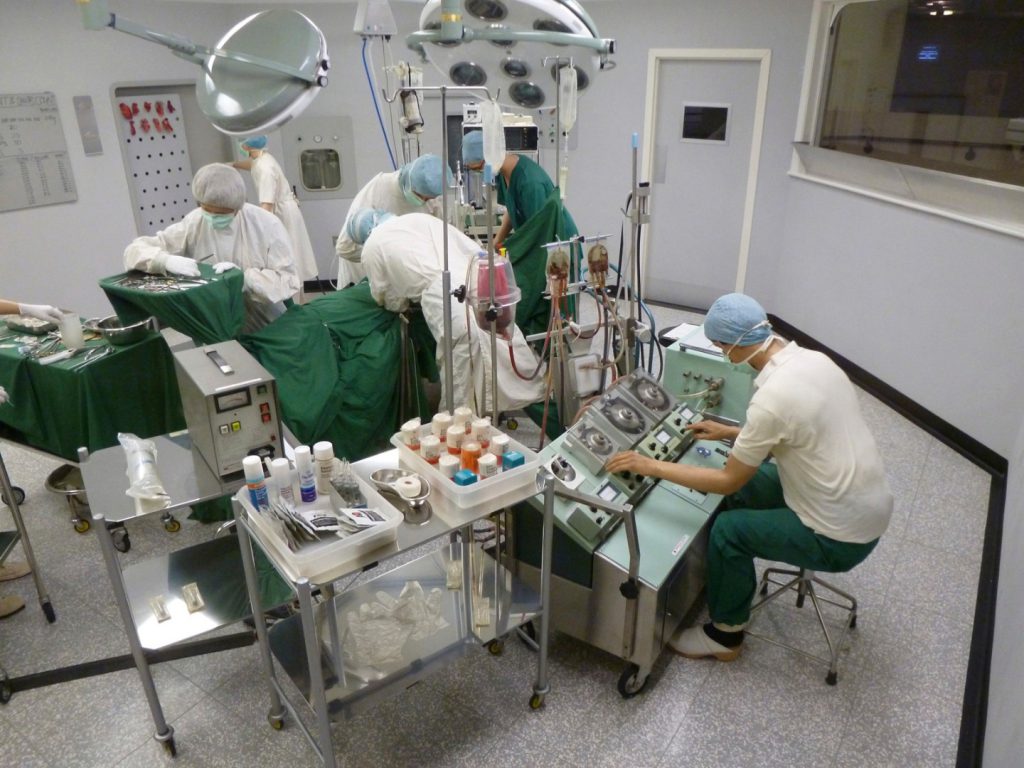
For more than three decades until 2016, the Science Museum’s Lower Wellcome Gallery included a life-size replica of an operating theatre, created in 1980 to show the latest in surgical technology at that time. Fully equipped with surgical and anaesthetic equipment, this ‘room set’ had remained all but untouched since its installation. The Museum gave me permission to invite surgical teams to re-enact procedures there. This provided an unusual opportunity to observe and film highly experienced teams as they went back in time. Much of what they did during these simulated operations took place beyond their conscious awareness, and on analysis of video recordings I was greatly struck by the way in which instruments were passed effortlessly between surgeons and nurse without the need for explicit requests.
Initial re-enactments with a long-retired surgical team (surgeon Professor Harold Ellis, anaesthetist Professor Stanley Feldman and Theatre Sister Mary Neiland) focused on removal of the gallbladder (open cholecystectomy), a commonly-performed operation which formed an essential part of every general surgeon’s repertoire. Post-simulation interviews with the participants showed that re-enacting this procedure, even after a gap of decades, prompted unexpected recollections of how they had once worked together and provided a glimpse into an otherwise undocumented past.
Further re-enactments focused on the early days of keyhole surgery, working with pioneers in the field (led by urologist Mr John Wickham and radiologist Dr Mike Kellett). In contrast to the team carrying out an operation that had remained stable for over fifty years (open cholecystectomy), the keyhole surgery innovators recalled having to improvise, to develop new instruments, to come up with creative solutions to unexpected problems and to develop a cohesive team of surgeon, scrub nurse, interventional radiologist and surgical instrument designer who worked together on equal terms – a radical change from traditional leadership models. Again, the process of physical re-enactment acted as a prompt to subsequent recollection, triggering memories which led from individual instruments and items of equipment to more general discussions about the events and challenges of the time.
A third exploration addressed some of the ‘dead ends and blind alleys’ of surgical innovation, the operations that were developed but never caught on because they were quickly superseded during times of rapid development, with new techniques emerging all around. For example, in the late 1980s Wickham worked closely with hepatobiliary surgeon Mr Chris Russell on the technique of laparoscopic cholecystotomy, or removal of gallstones while leaving the gallbladder inside. After performing a successful series of almost one hundred such procedures the team abandoned this approach when surgeons from France demonstrated that removal of the entire gallbladder by keyhole surgery was safe and effective (thereby eliminating the chance of gallstone recurrence). Yet the rapidity of innovation at that time meant that such approaches were little documented and rapidly disappeared from view. Simulation-based re-enactment proved effective in prompting the team’s collective recollections of that time, documenting perspectives that have eluded capture by other means.
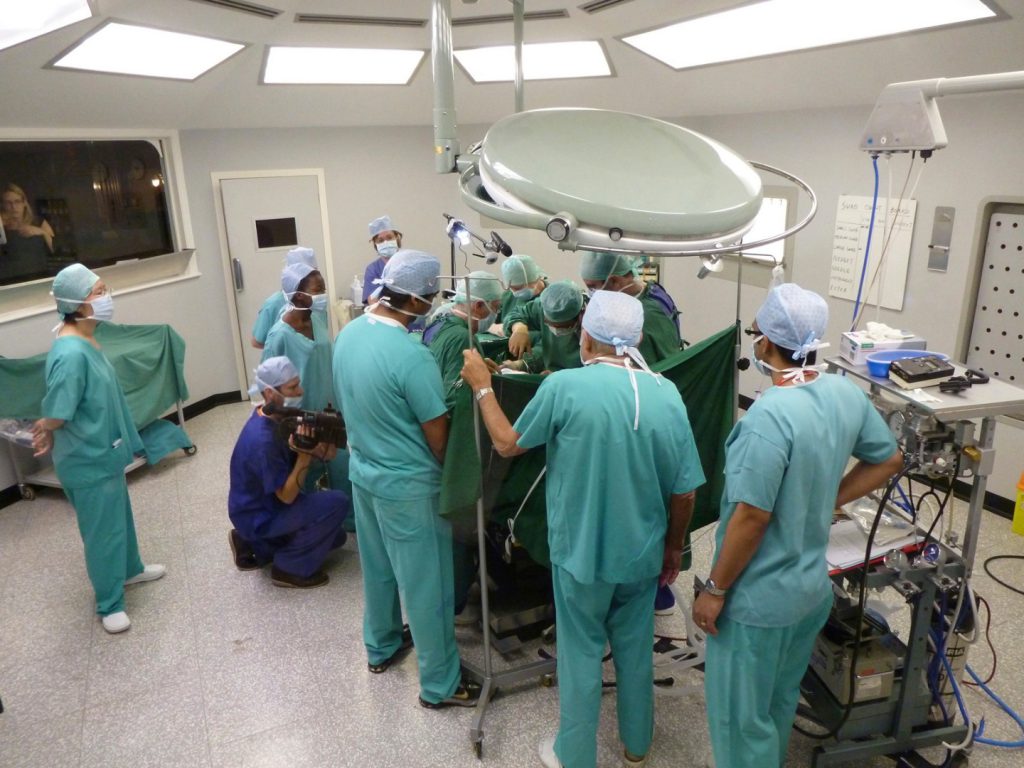
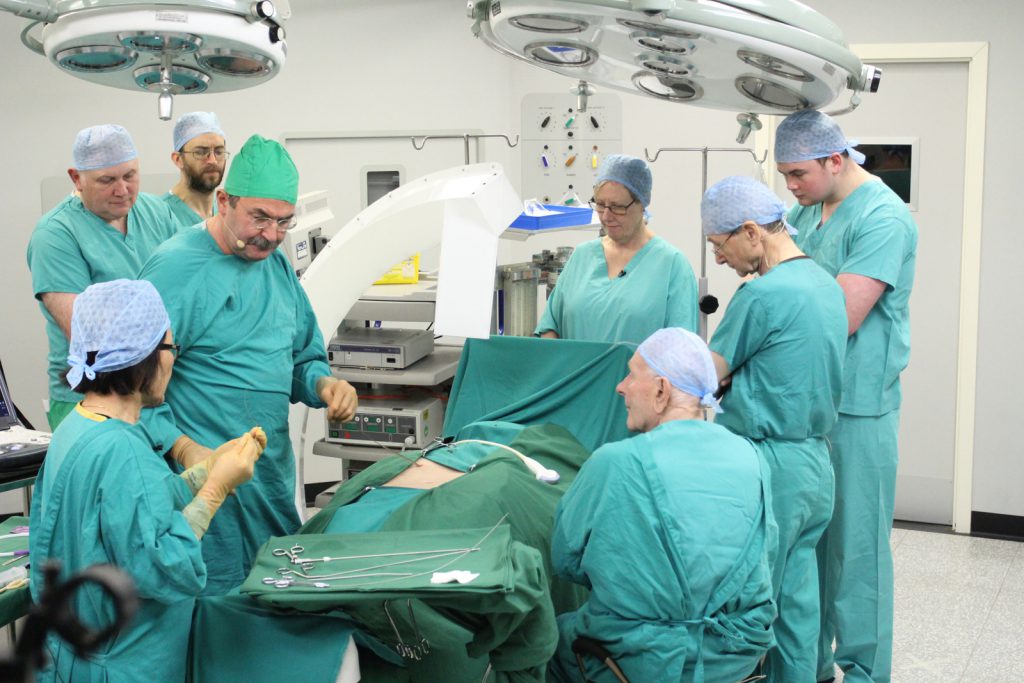
These simulations were designed largely for ‘insiders’ in surgery and medical history, allowing them to document the processes of surgical teamwork and record the histories of objects through use. Such objects included both established surgical instruments and emerging technology which at the time was entirely new. Leading on from these initial simulations, a subsequent project, the ‘Time Travelling Operating Theatre (TTOT)’ shifted focus from ‘insiders’ to ‘outsiders’ (patients and publics). This public engagement initiative invited members of the public to witness full-scale enactments of three ‘moments’ in surgical time – 1884, 1984 and 2016 – before taking part in discussion sessions with the clinical participants. Of course, only the second and third of these moments lie within living memory. The challenge of trying to recreate a sense of late nineteenth-century surgery from objects, contemporary accounts and written description threw into sharp focus the value of accessing professionals’ personal experience. Moreover, opening the world of surgery in this way brought additional perspectives and raised new questions which insiders had not thought to ask. These included ethical challenges around consent to undergo new and untried surgical procedures, the potential loss of valuable skills in the move from open to keyhole surgery, possible new directions shaped by developments in robotic technology, and questions about the nature and purpose of surgical instruments.
This use of physical simulation has brought into sharp relief the embodied knowing which lies at the heart of much expert practice, and the crucial role played by objects. Many of the objects in museum collections are of course too fragile or vulnerable to be used in simulations of this kind. However, there remain many that are sufficiently robust to be put to work, especially in the hands of experts accustomed to manipulating them. Such activities have a twofold effect. First, witnessing how objects are used in the context for which they were designed can provide important insights into the objects themselves, and how their form relates to their function. In the case of instruments and equipment tied to a particular historical moment, such information offers unique richness for historians, museum specialists and clinical professionals. Secondly, objects may act as prompts for recollection, either by individuals or (as in the surgical examples above) as members of a team. These recollections may ripple far beyond the activity itself, triggering deeper memories about conversations, events and insights. Yet such knowledge is vulnerable, as the people who hold it become old and frail. We have an opportunity to document this knowledge, using objects in museum collections to unlock rich stores of memory and chronicle their use, but this opportunity will not last indefinitely.
Capturing the tacit knowledge that underpins surgical practice is a daunting challenge. For experts, such knowledge has become so instinctive that they may not even recognise it. For those outside the field, the subtleties of this embodied knowing may be impossible to grasp fully. Yet such knowing lies at the heart of almost every professional domain. Objects offer a means of recognition, a way of bringing such knowing into view. Interacting with museum collections and documenting their histories through use presents an opportunity to capture what may otherwise remain unarticulated, hidden from insiders and outsiders alike.
Yves Winkin: Restoration of behaviour and re-enactment
https://dx.doi.org/10.15180/170808/005While the notion of re-enactment is well-known in the history of science, the notion of ‘restoration of behaviour’ seems to be confined to anthropology, where it was developed in the late 1970s by Richard Schechner. My suggestion here is that the two notions could be complementary and put to good use in either discipline. I am going to sketch the history of ‘restoration of behaviour’ and suggest usages in the history of science, especially when history is reconstructed in science museums, as is the case with Roger Kneebone’s re-enactment experiments.
Richard Schechner (born 1934) was trained both in drama and anthropology, and his entire career reflects that double interest, as expressed in the title of his 1985 book Between Theater and Anthropology, and shown in the content of The Drama Review of which he has been a long-standing editor. Schechner also co-founded and led for many years the Department of Performance Studies at New York University, which is unusual in its blending of humanities and social sciences, under the aegis of the over-arching notion of performance.
A word about performance before moving to restoration of behaviour: performance as conceptualised by Schechner is never solely a piece in a theory, as philosophers of language would have it. It is both acting on stage, in a very physical way, and acting on stage, in a very metaphorical way (Schechner, 1985, p 296):
There are two main realms of performance theory: (1) looking at human behaviour – individual and social – as a genre of performance; (2) looking at performances – of theatre, dance, and other ‘art forms’ – as a kind of personal or social interaction. These two realms, or spheres, can be metaphorically figured as interfacing at a double two-way mirror. From one face of the mirror persons interested in aesthetic genres peep through at ‘life’. From the other side, persons interested in the ‘social sciences’ peep through at ‘art’. Everything is in quotation marks because the categories are not settled. The very activity of peeping through unsettles the categories. Or, as Erving Goffman slyly remarked in 1959, ‘All the world is not, of course, a stage, but the crucial ways in which it isn’t are not easy to specify’.
Erving Goffman and his Presentation of Self in Everyday Life (1959) is seminal here because he offered a dramaturgical reading of face-to-face interactions, which was both deeply embedded in a long Shakespearian tradition and very fresh in the vocabulary used and the perspective developed. Speaking of front stage and back stage, Goffman saw interactions as performances: ‘Once we begin a performance, we are inclined to finish it, and we are sensitive to jarring notes which may occur during it. If we are caught out in a misrepresentation we feel deeply humiliated’ (1959, p 244). Schechner relied heavily on Goffman’s vision of the social world, as developed in his Presentation of Self. But another book by Goffman often quoted by Schechner should also be mentioned here: Frame Analysis (1974).
Anthropologist Gregory Bateson published a paper ‘A Theory of Play and Fantasy’ (1955), which also deeply influenced Goffman through the notion of ‘frame’. Bateson, a British-born anthropologist (or natural historian, as he liked to call himself), developed too many ideas to be presented here, but of particular relevance is his idea of frame in which every public activity has to be cued in order to be properly understood: ‘I am joking here’, for example. The cue does not need to be said: a smile or a wink may be sufficient to send the message, or rather to frame the wording as ‘this is play’. Goffman picked up this idea and developed it in 576 pages in his Frame Analysis: An Essay on the Organization of Experience. Frame Analysis is Goffman’s magnum opus, in which he tries to rebuild sociology from scratch. The book has not been as influential as Presentation of Self but it is a regular source of inspiration for Schechner. So, when the latter had to define ‘restored behaviour’ he went immediately to Frame Analysis: ‘Restored behaviour is living behaviour treated as a film director treats a strip of film’ (1985, p 35), with the ‘strip’ being defined by Goffman as ‘any arbitrary slice or cut from the stream of ongoing activity’ (1974, p 10).
An example of restored behaviour may make the idea clearer. We are in Plymouth Plantation, Massachusetts, 1627 – or rather in the immersive experience offered to visitors since the late 1960s. Actors dressed in seventeenth-century clothes speak to visitors in seventeenth-century English while going about their business, such as baking bread or cooking pork (with seventeenth-century recipes). This is what Schechner calls ‘restored behaviour’. We are indeed close to ‘re-enactment’ – to the point we may ask what is the difference, except for disciplinary origins?[2]
In order to suggest an answer, a third term may be injected into the discussion: replication. Since the early 1980s, as we all know, there have been ‘replications of historical experiments’ by historians of science such as Peter Heering (1992), Otto Sibum (1995), Elizabeth Cavicchi (2003), Alberto Martinez (2006) and many others. Those historians do not seem to use the terminology of re-enactment – and certainly not restoration of behaviour. They may at times use reworking, restaging, if not simply reproduction. But replication is their favourite term, and French-speaking historians have also adopted it, either as such: réplication (Gaudillière, 1994) or in French translation: reconstitution (Pestre, 1994).
Most replications focus on the construction of instruments as close as possible to the historical originals. Martinez (2006) is painstakingly meticulous in that respect, in order to debate with Heering (1992). But other scholars try as well to reconstruct the context around the instruments. Otto Sibum stands out here as the historian closest to an anthropological approach with his notion of ‘gestural knowledge’. Such a notion is certainly nothing new to scholars inspired by Marcel Mauss or André Leroy-Gourhan, but it certainly is a real breakthrough in the world of historians of science. Sibum applies the notion to both the tacit knowledge of the scientist who conducted the original experiment (such as Joule, who tapped into his brewing culture) and to the ‘complex of skills and forms of mastery developed in these real-time performances’ (Sibum, 1995a, p 76) by the historian replicating the experiment.
Playing with bodily orientations in space and bodily rhythms in time is essential in order to get in touch with the instruments, other people and processes involved in the experiment. Material objects (as well as accompanying texts) serve as a kind of choreography for this performance because they provide partial direction of our thinking and acting.
(Sibum, 1995b), p 27
We see how close Sibum stands to the notions of re-enactment and restoration of behaviour, while not using either of them. But he does see his work as a performance, just like scholars who speak of re-enactments or restorations of behaviour. We could also show how close Sibum is to the notion of embodiment. When he uses ‘gestural knowledge’ to both explain how Joule was able to produce such refined results and how he was able to understand ‘from within’ how Joule worked, he becomes Joule in a sense – he embodies Joule to the rhythm of his body, to the flare of his nostrils, to the light rake in his fingers. Exactly like the nurses and doctors of Roger Kneebone’s surgical re-enactments, who play their own role in order to revamp a memory partially lost. Exactly like Schechner’s observations of seventeenth-century behaviour restored by actors who confine their gestures and words to the world of seventeenth-century American settlement. But there is a limit to the possibility of historical embodiment: Sibum will never be Joule, and a twentieth-century actor will never be a seventeenth-century settler – while older Kneebone may be younger Kneebone at the time of a performance.
All this is to say (to return to our question) that there is no fundamental difference between restoration of behaviour and re-enactment. Both notions have to do with performing the past, embodying characters and framing activities. Both notions can be applied in a wild range of contexts, from the re-enactment of military battles to religious festivals (seen as restoration of divine behaviour). However, while re-enactment may have saturated its analytical potential in the history of science, and may just be used today as a methodological label in the field (like replication), it may well be that restoration of behaviour still has potential for analysis (like gestural knowledge) because Schechner spent quite some time conceptualising it and modelling it. Just apply this excerpt to Otto Sibum enacting Joule while accumulating ‘gestural knowledge’:
Put in personal terms, restored behaviour is ‘me behaving as if I am someone else’ or ‘as if I am “beside myself”, or “not myself”’, as when in trance. But this ‘some[one]else’ may also be ‘me in another state of feeling/being’, as if there were multiple ‘me’s’ in each person […] Restored behaviour offers to both individuals and groups the chance to rebecome what they once were – or even, and most often, to rebecome what they never were but wish to have been or wish to become.
(Schechner, 1985), p 37 and p 38
Richard Schechner and Otto Sibum ought to get together at some point.
Tim Boon: Conclusions
https://dx.doi.org/10.15180/170808/006Many other examples of the application of practical investigative research to understanding past practice might have been brought forward for consideration here, and the selection here simply reflects the work of investigators who were able to attend our conference. To give one further example, the work of John Ellis’s ADAPT team researching the history of televisual technique is highly suggestive. In that project, it has been possible to reveal and record the techniques that technicians used in major areas of television-making, including interview setups and outside broadcasts. The availability of both technicians with experience of older techniques and of historical equipment has been essential to the success of the project (Ellis, 2015). This example, like the majority of Roger Kneebone’s work achieves a more haptically-rich account of past practice than is available from conventional written sources. In placing the emphasis on what can be experienced, Peter Heering’s case study shows how practical investigations can enlarge our felt understanding of what happened in the past, at the same time as we re-join historical artefacts with their pre-museum use histories. Yves Winkin suggests that there are intellectual traditions that hold the potential not only to understand, but to interrogate, the phenomena we are seeking to understand and to record. Klaus Staubermann’s argument takes us from questions of evidence to potentials for public engagement in what we discover. In toto, as Heering comments: ‘practical experiences benefit from these insights, and the insights benefit from the practical experiences.’
Tags
Footnotes
Back to text
Back to text






